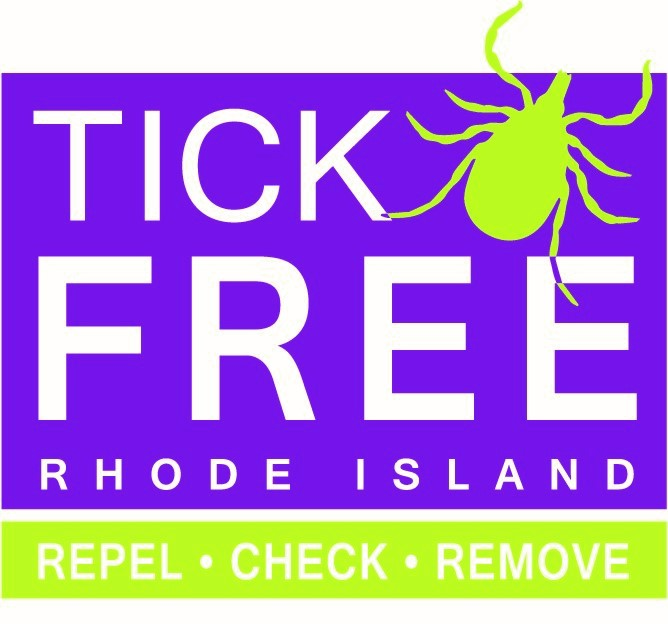RIDOH, DEM Annual Lyme Disease Prevention Campaign Urges Residents to Avoid Tick Bites when Outdoors
EDITOR'S NOTE: Anecdotally, I can attest to likelihood that this will be a bad tick summer in Charlestown. Last month, I was picking daffodils along the wood's edge. Within an hour of coming inside, I picked six ticks crawling on me and later, found one that had bit me. I removed it with my trusty tick tweezers, but it still left a mark that hasn't healed yet. If you go anywhere near the woods, you will get ticks on you unless you are heavily dosed with permethrin. - W. Collette
For Rhode Islanders to enjoy the outdoors safely, it is
important they be aware of ticks and the diseases these arachnids carry. Rhode
Island continues to be a high-incidence state for Lyme disease. According to
RIDOH disease data, Rhode Island had 839 cases of Lyme disease in 2020, with an
incidence rate of 77 cases per 100,000.
"While Rhode Islanders are enjoying the great outdoors, we need to make sure we're all taking these three key steps to preventing Lyme and other tick-borne diseases: Repel, Check, Remove," said Interim Director of Health James McDonald, MD, MPH.
"Repel and reduce your exposure to ticks,
check your body for ticks in the spots that they like to crawl and hide, and be
sure to promptly and properly remove ticks if you find one on yourself, your
family members, or your pets. Ticks are tiny and you may not be able to feel
them or spot them right away. The sooner you find and remove them, the better
your chances are at preventing the potential for very serious health issues
caused by Lyme and other diseases ticks carry."
Increasing numbers of ticks could be attributed to a variety of environmental factors that are symptomatic of climate change such as more moderate winters (allowing ticks that are alive in autumn to survive over the winter), hotter temperatures in the summer, and more rainfall.
Rhode Island's
Lyme disease prevention work is part of larger efforts toward building greater
community resilience, which will help communities prepare for, respond to, and recover
from the adverse health effects of climate change.
"As the weather warms and Rhode Islanders begin returning
to state parks, campgrounds, and management areas, so do ticks," said DEM
Acting Director Terry Gray. "DEM and the Rhode Island Department of Health
cooperate on a wide array of programs and initiatives to protect public health.
Public education is critical. Again this year, DEM welcomes the chance to make
RIDOH's informative tick bite-prevention materials available for our park and
campground visitors."
RIDOH's ongoing Tick Free Rhode Island campaign highlights the
three keys to tick safety: repel, check, and remove.
Repel
Keep ticks off you, your children, and pets by:
o Avoiding wooded and brushy areas with high grass and leaves.
If you are going to be in a wooded area, walk in the center of the trail to
avoid contact with overgrown grass, brush, and leaves at the edges of the
trail. You can also spray your clothes with permethrin to keep ticks away. Make
sure to not spray this on your skin.
o Wearing long pants and long-sleeve shirts when outside.
o Tucking your pants into your socks so ticks do not crawl under
your clothes.
o Wearing light-colored clothing so you can see ticks more
easily.
Check
Check yourself, your children, and pets, for ticks by:
o Taking a shower as soon as you come inside if you have been in
grassy or wooded areas.
o Doing a full-body tick check using a mirror; parents should
check their kids for ticks and pay special attention to the area in and around
the ears, in the belly button, behind the knees, between the legs, around the
waist, and in their hair.
o Checking your pets for ticks as well because they can bring
ticks into the home.
Remove
Remove ticks from your body, as well as from children and
pets, if you find them.
o Use a set of tweezers to remove the tick. Grasp the tick as
close to the skin as possible and pull straight up.
o If you don't have tweezers, use your fingers with a tissue or
rubber gloves.
Most people who get Lyme disease get a rash anywhere on their
body, though it may not appear until long after the tick bite (70-80% of people
with Lyme disease will develop a rash, according to the US Centers for Disease
Control and Prevention). At first, the rash looks like a red circle, but as the
circle gets bigger, the middle changes color and seems to clear, so the rash
looks like a target bull's-eye.
Some people don't get a rash but feel sick, with headaches,
fever, body aches, and fatigue. Over time, they could have swelling and pain in
their joints and a stiff, sore neck; or they could develop shooting pains,
numbness, or tingling in the hands or feet, or facial drooping from nerve
palsy. A few people may even experience heart problems. Lyme disease can be
treated with antibiotics.
Rhode Island's Lyme disease prevention work is part of larger
efforts toward building greater community resilience, which will help
communities prepare for, respond to, and recover from the adverse health
effects of climate change.
The Tick Free Rhode Island campaign features three animated Tick
Free Rhode Island videos. The videos show how to repel both ticks and
mosquitoes, how to check for ticks, and how to properly remove a tick from the
skin. RIDOH's Rhode Island Tick Detective Workbook for Kids is also available
online. To view the videos and get more information on Lyme disease and other
tick-borne diseases, visit health.ri.gov/ticks.
Related
links
